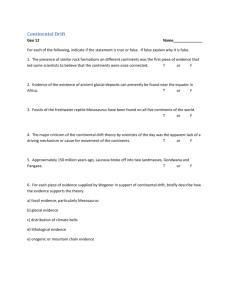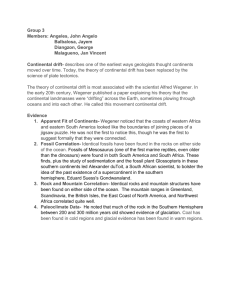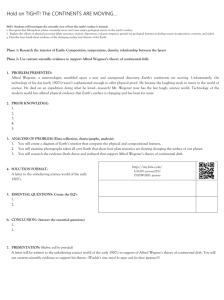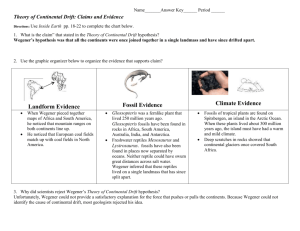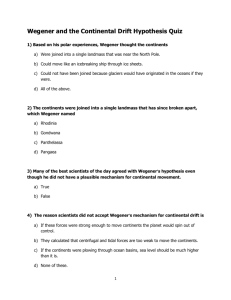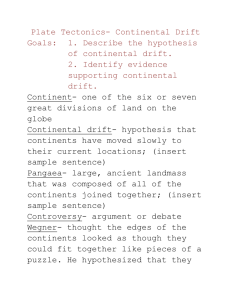Evidence of continental`drift`
advertisement
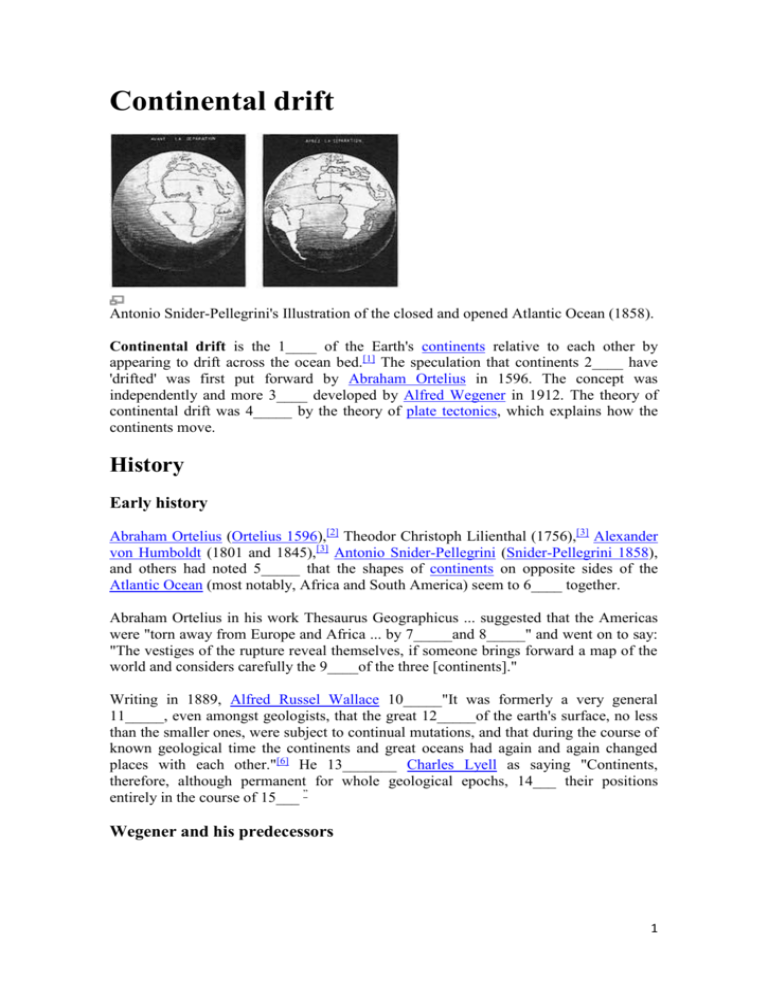
Continental drift Antonio Snider-Pellegrini's Illustration of the closed and opened Atlantic Ocean (1858). Continental drift is the 1____ of the Earth's continents relative to each other by appearing to drift across the ocean bed.[1] The speculation that continents 2____ have 'drifted' was first put forward by Abraham Ortelius in 1596. The concept was independently and more 3____ developed by Alfred Wegener in 1912. The theory of continental drift was 4_____ by the theory of plate tectonics, which explains how the continents move. History Early history Abraham Ortelius (Ortelius 1596),[2] Theodor Christoph Lilienthal (1756),[3] Alexander von Humboldt (1801 and 1845),[3] Antonio Snider-Pellegrini (Snider-Pellegrini 1858), and others had noted 5_____ that the shapes of continents on opposite sides of the Atlantic Ocean (most notably, Africa and South America) seem to 6____ together. Abraham Ortelius in his work Thesaurus Geographicus ... suggested that the Americas were "torn away from Europe and Africa ... by 7_____and 8_____" and went on to say: "The vestiges of the rupture reveal themselves, if someone brings forward a map of the world and considers carefully the 9____of the three [continents]." Writing in 1889, Alfred Russel Wallace 10_____"It was formerly a very general 11_____, even amongst geologists, that the great 12_____of the earth's surface, no less than the smaller ones, were subject to continual mutations, and that during the course of known geological time the continents and great oceans had again and again changed places with each other."[6] He 13_______ Charles Lyell as saying "Continents, therefore, although permanent for whole geological epochs, 14___ their positions entirely in the course of 15___ ” Wegener and his predecessors 1 Alfred Wegener The 16_____ that the continents had once formed a single 17______ before breaking apart and drifting to their present locations was first presented by Alfred Wegener to the German Geological Society on 6 January 1912.[11] Although Wegener's theory was formed independently and was more complete than those of his predecessors, Wegener later credited a number of past authors with similar ideas:[12][13] For example: the similarity of 18_____ continent geological formations had led Roberto Mantovani to conjecture in 1889 and 1909 that all the continents had once been 19___ into a supercontinent (now known as Pangaea); Wegener noted the similarity of Mantovani's and his own maps of the former positions of the southern continents. Wegener was the first to use the phrase "continental drift" (1912, 1915)[11][12] (in German "die Verschiebung der Kontinente" –20______ into English in 1922) and formally publish the hypothesis that the continents had somehow "drifted" apart. Although he presented much evidence for continental drift, he was 21 _____ to provide a convincing explanation for the physical processes which might have caused this drift. His 22_____ that the continents had been pulled apart by the centrifugal pseudoforce (Polflucht) of the Earth's rotation or by a small component of astronomical precession was rejected as calculations showed that the force was not sufficient.[20] The Polflucht hypothesis was also studied by Paul Sophus Epstein in 1920 and found to be 23_______. Evidence of continental'drift' Fossil 24 ________ across continents (Gondwanaland). 2 Mesosaurus skeleton, MacGregor, 1908. Evidence for the movement of continents on tectonic plates is now extensive. Similar plant and animal fossils are found around different continent 25_____, suggesting that they were once joined. The fossils of Mesosaurus, a 26______ reptile rather like a small crocodile, found both in Brazil and South Africa, are one example; another is the discovery of fossils of the land reptile Lystrosaurus from rocks of the same 27___ from locations in South America, Africa, and Antarctica.[21] There is also living evidence— the same animals being found on two continents. Some earthworm families (e.g.: Ocnerodrilidae) are found in South America and Africa, for instance. The complementary 28 _____ of the facing sides of South America and Africa is obvious, but is a temporary coincidence. 29 _____ distribution of Permo-Carboniferous glacial sediments in South America, Africa, Madagascar, Arabia, India, Antarctica and Australia was one of the major pieces of evidence for the theory of continental drift. The continuity of glaciers, inferred from oriented glacial striations and deposits called tillites, suggested the existence of the supercontinent of Gondwana, which became a central element of the concept of continental drift. Striations indicated glacial 30 __ away from the equator and toward the poles, in modern coordinates, and supported the idea that the southern continents had previously been in dramatically different locations, as well as contiguous with each other.[12] Rejection of Wegener's theory, and subsequent vindication The theory of continental drift was not accepted for many years. One problem was that a plausible driving force was missing.[1] And it did not help that Wegener was not a geologist. Other geologists also believed that the evidence that Wegener had provided was not sufficient. It is now accepted that the plates carrying the continents do move across the Earth's surface; ironically one of the chief 31 ___ questions is the one Wegener failed to resolve: what is the nature of the forces propelling the plates?[1] The British geologist Arthur Holmes championed the theory of continental drift at a time when it was deeply 32 ___. He proposed that the Earth's mantle contained convection cells that dissipated radioactive 33 ___ and moved the 34 ___ at the surface. His Principles of Physical Geology, ending with a chapter on continental drift, was published in 1944.[22] David Attenborough, who attended university in the second half of the 1940s, recounted an incident illustrating its lack of acceptance then: "I 35 ____ asked one of my 36 __ why he was not talking to us about continental drift and I was told, sneeringly, that if I could I prove there was a force that could move continents, then he might think about it. The idea was moonshine, I was informed."[23] 3 It is now known that there are two kinds of crust, continental crust and oceanic crust. Continental crust is inherently lighter and of a different composition to oceanic crust, but both kinds reside above a much deeper "plastic" mantle. Oceanic crust is created at spreading centers, and this, along with subduction, drives the system of plates in a chaotic manner, resulting in continuous orogeny and areas of isostatic imbalance. The theory of plate tectonics explains all this, including the movement of the continents, better than Wegener's theory. Alfred Wegener, around 1925 The determined age of the Earth as 2 billion years opened doors for theories of continental movement during this vast amount of time.[25] In 1912 Alfred Wegener proposed the theory of Continental Drift.[26] This theory suggests that the continents were joined together at a certain time in the past and formed a single landmass known as Pangaea; thereafter they drifted like rafts over the ocean floor, finally reaching their present position. The shapes of continents and matching coastline geology between some continents indicated they were once attached together as Pangea. Additionally, the theory of continental drift offered a possible explanation as to the formation of mountains. From this, different theories developed as to how mountains were built. Unfortunately, Wegener’s ideas were not accepted during his lifetime and his theory of Continental Drift was not accepted until the 1960s.[27] In the 1960s new found evidence supported the theory of Continental Drift. The term Continental Drift was no longer used but was replaced by the concept of Plate Tectonics that was well supported and accepted by almost all geologists by the end of the decade. Geophysical evidence suggested lateral motion of continents and that oceanic crust is younger than continental crust. This geophysical evidence also spurred the hypotheses of seafloor spreading and paleomagnetism. The hypothesis of seafloor spreading, proposed by Robert S. Dietz and Harry H. Hess, holds that the oceanic crust forms as the seafloor spreads apart along mid-ocean ridges. Paleomagnetism is the record of the orientation of the Earth’s magnetic field recorded in magnetic minerals. British geophysicist S. K. Runcorn suggested the concept of paleomagnetism from his finding that the continents had moved relative to the Earth’s magnetic poles. 4 5


